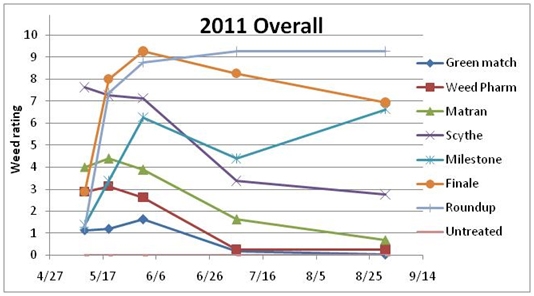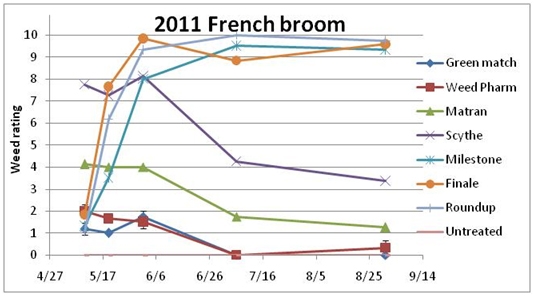2010-2011 Roadside Weed Control Evaluation with Organic and Conventional Herbicides
Richard Smith and Steve Tjosvold, Farm Advisors
University of California Cooperative Extension, Monterey and Santa Cruz Counties
A trial was established near Bonny Doon, California (in the Santa Cruz mountains). The objective of the trial was to screen alternative roadside herbicides in the wake of the ban on the use of glyphosate for roadside weed control imposed by the Santa Cruz County board of supervisors in 2005. The plots were in an area that had large population of French broom. Other weeds present at the site included California blackberry, perennial pea and grass weeds. Each plot was 15 feet long by 5 feet wide. One application of the treatments show in Table 1 were made each year of the trial: May 4, 2010 and May 5, 2011. Treatments were applied with three passes of a one-tip wand with one 8005VS air induction nozzle applying the equivalent of 50 gallons of water per acre. Air temperatures on the day of application were warm, 75º F and 81° F in 2010 and 2011, respectively. Weed control evaluations were carried out 7, 14, 28, 56 and 112 days after application by rating the percent of weed control on the following scale: 0 = no weed control to 10 weed completely dead. Treatments included in the trial were the organic herbicides, Greenmatch EX and Matran and Weed Pharm, as well as the “softer” herbicide, Scythe, to evaluate see what was the potential of these types of materials to control roadside weeds and in particular, French broom. Two conventional herbicides, Milestone VM Plus and Finale were also included and Roundup was the standard.
Table 1. Treatments in trial
|
Product Trade Name |
Active Ingredient |
Activity |
lb a.i./A |
Product/A |
Safety Information |
|
Greenmatch EX |
lemongrass oil |
Contact |
15% v/v |
7.5 gals |
organic “caution” |
|
Weed Pharm |
acetic acid (20%) |
Contact |
100% v/v |
50 gals |
organic “danger” |
|
Matran |
clove oil |
Contact |
15% v/v |
7.5 gals |
organic “caution” |
|
Scythe |
pelargonic acid |
Contact |
9% v/v |
4.5 gals |
“caution” |
|
Milestone VM Plus |
aminopyralid triclopyr |
Locally systemic |
0.22 ae |
9.0 qts |
“caution” |
|
Finale |
glufosinate |
Locally systemic |
3% v/v |
1.5 gals |
“warning” |
|
Roundup |
glyphosate |
Systemic |
2% v/v |
1.0 gal |
“caution” |
|
Untreated |
--- |
--- |
Surfactants: Nufilm P, 0.25% v/v added to Greenmatch, WeedPharm, and Matran. Dynamic added 0.25% v/v to Milestone VM Plus.
The 2011 data is included here and illustrates the strengths and weaknesses of each material. On the seven day after treatment evaluation date the organic herbicides, Greenmatch, Weed Pharm and Matran had their greatest effect. They burned the foliage of many weeds and French broom, but the plants quickly recovered and the overall weed control that they provided declined over time (Figures 1 & 2). Scythe provided a much greater level of control than the organic herbicides, but its impact also declined over time; however, its effect did not decline to near zero as did the organic herbicides. Milestone, Finale and Roundup all had low weed control ratings on the 7 day evaluation, but quickly increased to high levels of control. All three of these material provided good control of French broom. Milestone had lower overall weed control, because it did not control grass weeds; however, this effect could be used as a strategy in vegetation management. Overall, this trial illustrated the strengths and weaknesses of various herbicide control methods. We are following up this study by conducting a repeat application study with Scythe.
Figure 1. Overall vegetation control
Figure 2. French broom control

